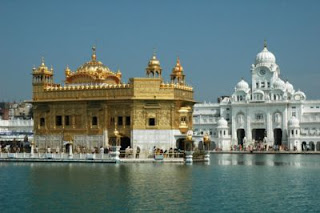Badrinath – The Abode of Saints and Seers Pilgrimage near Uttar Pradesh India
Ayodhya – The Birthplace of Lord Rama
The Golden Temple in Amritsar Welcomes All
Amarnath – Enjoy the Yatra
Allahabad Pilgrimage Tour
Feel the Blessings of a Sufi Saint at Ajmer Sharif

Ajmer Sharif in Rajasthan is situated at a distance of 135 kilometers from the city of Jaipur. It is one of the most sacred places for Muslims and is the burial site of Sufi saint Khwaja Muin-ud-din Chisti. Hundreds of people of all faiths visit the tomb of this Sufi saint all round the year. Though the saint died in the year 1236, Humayun erected a shrine in his honor a few years later. Thereafter, many Mughal rulers added more mosques in this Dargah complex. Indian Emperor Akbar was a staunch follower of Khwaja Muin-ud-din Chisti and made annual pilgrimage to Ajmer Sharif from Agra.
One of the main highlights of this religious site is that all the donations made in the cauldrons present in the Dargah are later divided among the poor. Every devotee who enters the Dargah should cover his or her head with a piece of cloth. The main entrance of this Muslim pilgrimage site is from the Dargah Bazar and it opens into the first courtyard. The saint’s tomb is present in the second courtyard, right in its center. Ajmer Sharif attracts huge crowds on the death anniversary of the saint. You can plan your visit to coincide with this day or the Urs festival.
About chidabaram south india pilgrimage
Like Us on Facebook
Categories
- About chidabaram south india pilgrimage (1)
- Ajmer (1)
- Allahabad Pilgrimage (1)
- Amarnath (2)
- Amarnath – Enjoy the Yatra (1)
- Amritsar (1)
- Atala Masjid (1)
- Atala Masjid Jaunpur Uttar Pradesh (1)
- Badrinath – The Abode of Saints and Seers (1)
- Bangalore (1)
- Bangalore Temple (1)
- Dhams (1)
- Dwarka (1)
- Ekambareswarar Temple (1)
- Gangaikonda Cholapuram Temple (1)
- Gangaikondacholapuram Temple (1)
- Guruvayoor Sree Krishna Temple (1)
- ISKCON Bangalore Temple (1)
- ISKCON Temple (1)
- Jagannath Puri (1)
- Jyotirlingas (1)
- Kailasanathar (1)
- Kailasanathar India (1)
- Kailasanathar Siva Temple (1)
- Kanchipuram (1)
- Kerala (2)
- Kerala temple (1)
- Laxmi Narayan Temple Himachal Pradesh .temples in Himachal Pradesh (1)
- North Indian Temples (4)
- Pilgrimage near Uttar Pradesh India (1)
- Sabarimala (1)
- Sabarimala Sree Ayyappa Temple (1)
- Shirdi (1)
- south india pilgrimage (1)
- South Indian Temples (2)
- Sree Ayyappa (1)
- Sun temple – Black Pagoda (1)
- Tamil Nadu (1)
- Temple in Kerala (1)
- temples in tamil nadu (2)
- Tirupati (1)
- Tirupati Tirumala Balaji Temple (1)
- Vaishno Devi (1)
Popular Posts
-
The Guruvayoor Temple is nearly 29 km north-west in the Thrissur. The Guruvayoor temple got its name from the word Guruvayoorappan me...
-
Tirupati, one of the richest temples in the country, is the most venerated Vaishnavite shrine of Lord Ve...
-
Gangaikonda Cholapuram Temple is an architectural work of some genius peoples. Situated at Thanjavur (Tanjore) in Tamil Nadu, Gangaikon...
















